Breast Cancer - Causes, Symptoms and Treatment
VerifiedAdded on 2022/03/25
|6
|1406
|26
AI Summary
Breast cancer is usually a condition where cells grow in a breast without control. We have different types of breast cancer. These types depend on the call in a breast that turns to cancer. Symptoms include; breast thickening or lump that usually feels very different from nearby cells—the shape of the breast changes appearing different from the actual. Treatments include; surgery, which involves removing the breast (mastectomy) or removing of tumor only and the tissue around it. Radiation therapy makes the use of energy waves to kill the cancer cell (s).
Contribute Materials
Your contribution can guide someone’s learning journey. Share your
documents today.

Running head: CANCER 1
BREAST CANCER
Name of the student
Professor/instructor’s name
Class/unit
Date submitted
.
BREAST CANCER
Name of the student
Professor/instructor’s name
Class/unit
Date submitted
.
Secure Best Marks with AI Grader
Need help grading? Try our AI Grader for instant feedback on your assignments.
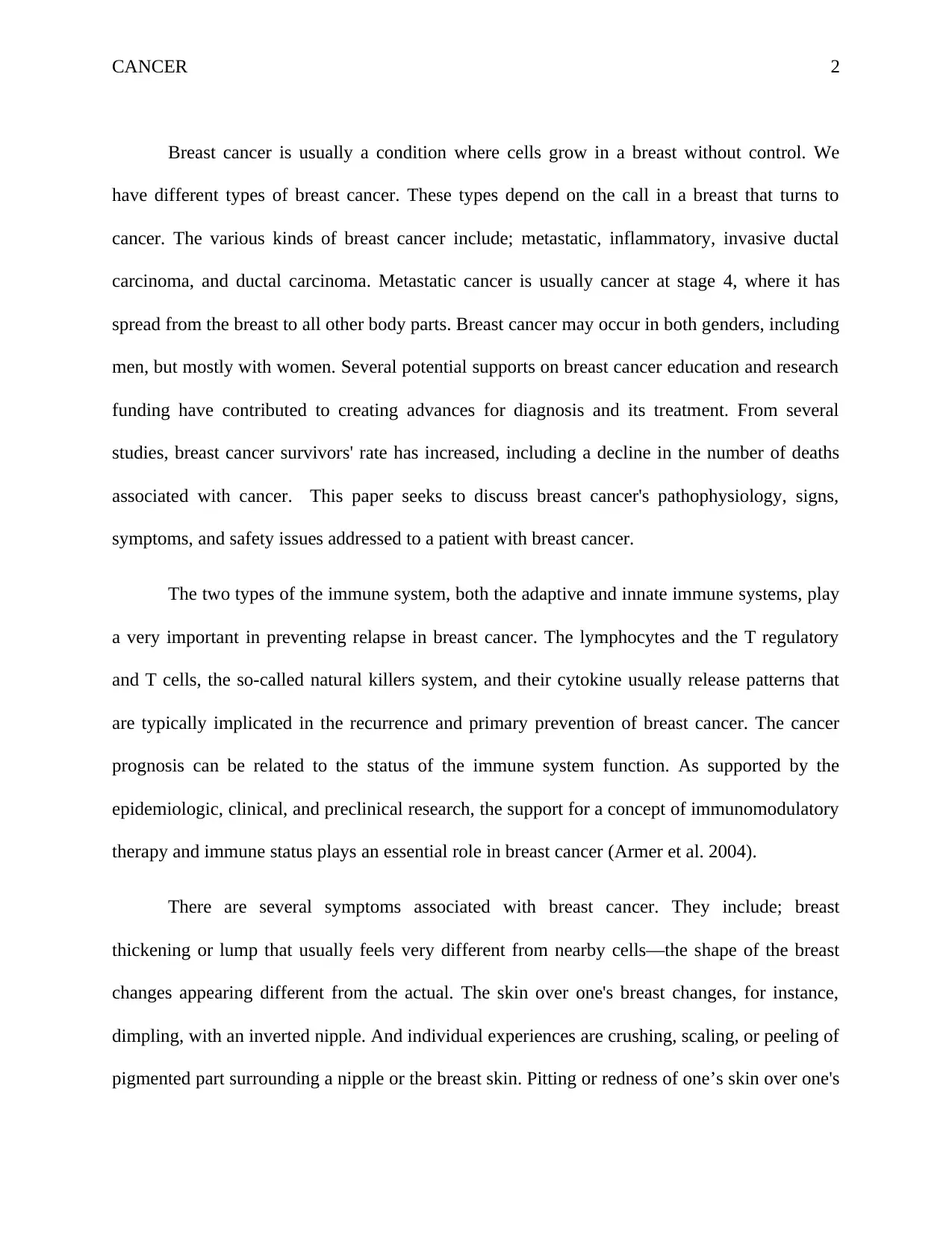
CANCER 2
Breast cancer is usually a condition where cells grow in a breast without control. We
have different types of breast cancer. These types depend on the call in a breast that turns to
cancer. The various kinds of breast cancer include; metastatic, inflammatory, invasive ductal
carcinoma, and ductal carcinoma. Metastatic cancer is usually cancer at stage 4, where it has
spread from the breast to all other body parts. Breast cancer may occur in both genders, including
men, but mostly with women. Several potential supports on breast cancer education and research
funding have contributed to creating advances for diagnosis and its treatment. From several
studies, breast cancer survivors' rate has increased, including a decline in the number of deaths
associated with cancer. This paper seeks to discuss breast cancer's pathophysiology, signs,
symptoms, and safety issues addressed to a patient with breast cancer.
The two types of the immune system, both the adaptive and innate immune systems, play
a very important in preventing relapse in breast cancer. The lymphocytes and the T regulatory
and T cells, the so-called natural killers system, and their cytokine usually release patterns that
are typically implicated in the recurrence and primary prevention of breast cancer. The cancer
prognosis can be related to the status of the immune system function. As supported by the
epidemiologic, clinical, and preclinical research, the support for a concept of immunomodulatory
therapy and immune status plays an essential role in breast cancer (Armer et al. 2004).
There are several symptoms associated with breast cancer. They include; breast
thickening or lump that usually feels very different from nearby cells—the shape of the breast
changes appearing different from the actual. The skin over one's breast changes, for instance,
dimpling, with an inverted nipple. And individual experiences are crushing, scaling, or peeling of
pigmented part surrounding a nipple or the breast skin. Pitting or redness of one’s skin over one's
Breast cancer is usually a condition where cells grow in a breast without control. We
have different types of breast cancer. These types depend on the call in a breast that turns to
cancer. The various kinds of breast cancer include; metastatic, inflammatory, invasive ductal
carcinoma, and ductal carcinoma. Metastatic cancer is usually cancer at stage 4, where it has
spread from the breast to all other body parts. Breast cancer may occur in both genders, including
men, but mostly with women. Several potential supports on breast cancer education and research
funding have contributed to creating advances for diagnosis and its treatment. From several
studies, breast cancer survivors' rate has increased, including a decline in the number of deaths
associated with cancer. This paper seeks to discuss breast cancer's pathophysiology, signs,
symptoms, and safety issues addressed to a patient with breast cancer.
The two types of the immune system, both the adaptive and innate immune systems, play
a very important in preventing relapse in breast cancer. The lymphocytes and the T regulatory
and T cells, the so-called natural killers system, and their cytokine usually release patterns that
are typically implicated in the recurrence and primary prevention of breast cancer. The cancer
prognosis can be related to the status of the immune system function. As supported by the
epidemiologic, clinical, and preclinical research, the support for a concept of immunomodulatory
therapy and immune status plays an essential role in breast cancer (Armer et al. 2004).
There are several symptoms associated with breast cancer. They include; breast
thickening or lump that usually feels very different from nearby cells—the shape of the breast
changes appearing different from the actual. The skin over one's breast changes, for instance,
dimpling, with an inverted nipple. And individual experiences are crushing, scaling, or peeling of
pigmented part surrounding a nipple or the breast skin. Pitting or redness of one’s skin over one's
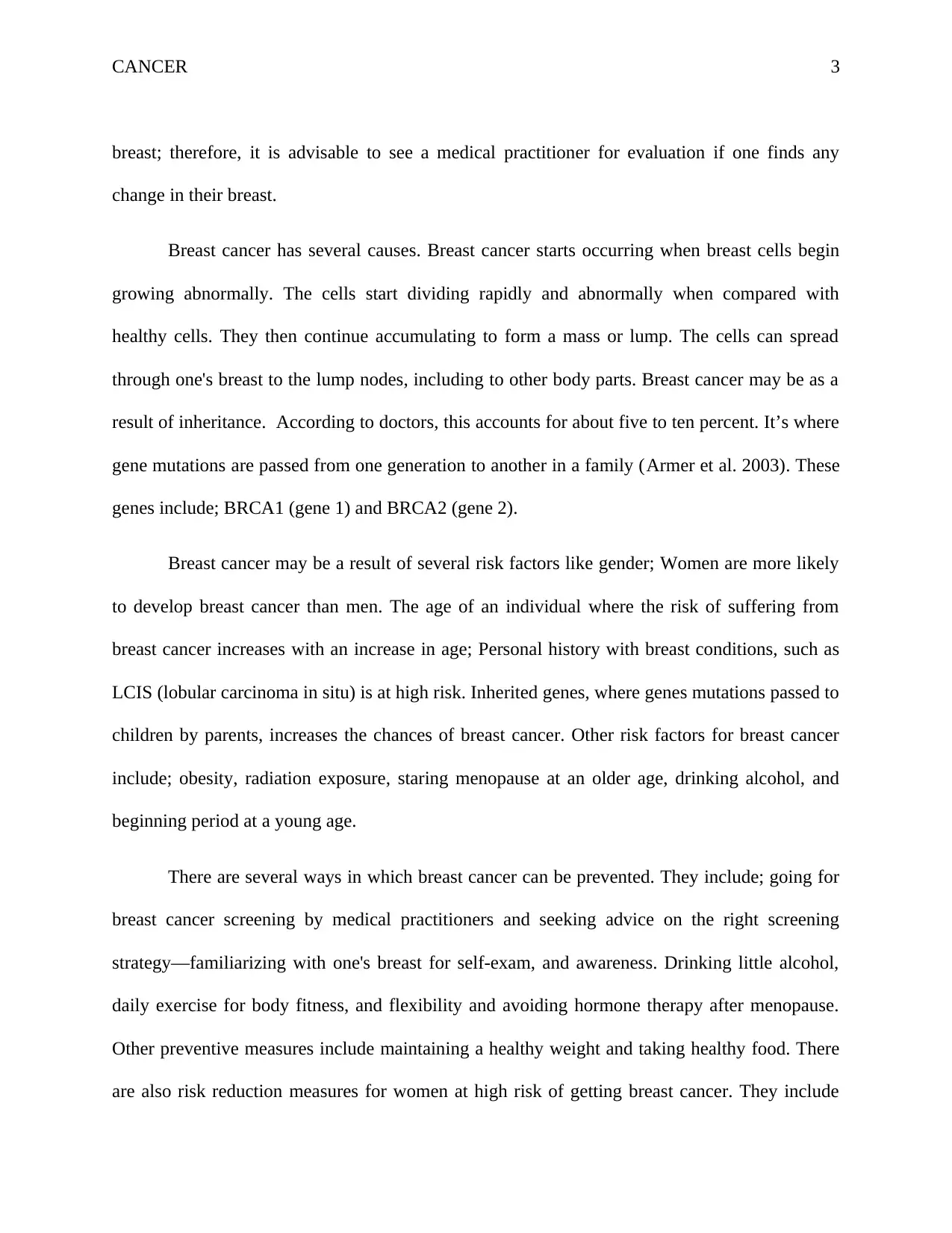
CANCER 3
breast; therefore, it is advisable to see a medical practitioner for evaluation if one finds any
change in their breast.
Breast cancer has several causes. Breast cancer starts occurring when breast cells begin
growing abnormally. The cells start dividing rapidly and abnormally when compared with
healthy cells. They then continue accumulating to form a mass or lump. The cells can spread
through one's breast to the lump nodes, including to other body parts. Breast cancer may be as a
result of inheritance. According to doctors, this accounts for about five to ten percent. It’s where
gene mutations are passed from one generation to another in a family (Armer et al. 2003). These
genes include; BRCA1 (gene 1) and BRCA2 (gene 2).
Breast cancer may be a result of several risk factors like gender; Women are more likely
to develop breast cancer than men. The age of an individual where the risk of suffering from
breast cancer increases with an increase in age; Personal history with breast conditions, such as
LCIS (lobular carcinoma in situ) is at high risk. Inherited genes, where genes mutations passed to
children by parents, increases the chances of breast cancer. Other risk factors for breast cancer
include; obesity, radiation exposure, staring menopause at an older age, drinking alcohol, and
beginning period at a young age.
There are several ways in which breast cancer can be prevented. They include; going for
breast cancer screening by medical practitioners and seeking advice on the right screening
strategy—familiarizing with one's breast for self-exam, and awareness. Drinking little alcohol,
daily exercise for body fitness, and flexibility and avoiding hormone therapy after menopause.
Other preventive measures include maintaining a healthy weight and taking healthy food. There
are also risk reduction measures for women at high risk of getting breast cancer. They include
breast; therefore, it is advisable to see a medical practitioner for evaluation if one finds any
change in their breast.
Breast cancer has several causes. Breast cancer starts occurring when breast cells begin
growing abnormally. The cells start dividing rapidly and abnormally when compared with
healthy cells. They then continue accumulating to form a mass or lump. The cells can spread
through one's breast to the lump nodes, including to other body parts. Breast cancer may be as a
result of inheritance. According to doctors, this accounts for about five to ten percent. It’s where
gene mutations are passed from one generation to another in a family (Armer et al. 2003). These
genes include; BRCA1 (gene 1) and BRCA2 (gene 2).
Breast cancer may be a result of several risk factors like gender; Women are more likely
to develop breast cancer than men. The age of an individual where the risk of suffering from
breast cancer increases with an increase in age; Personal history with breast conditions, such as
LCIS (lobular carcinoma in situ) is at high risk. Inherited genes, where genes mutations passed to
children by parents, increases the chances of breast cancer. Other risk factors for breast cancer
include; obesity, radiation exposure, staring menopause at an older age, drinking alcohol, and
beginning period at a young age.
There are several ways in which breast cancer can be prevented. They include; going for
breast cancer screening by medical practitioners and seeking advice on the right screening
strategy—familiarizing with one's breast for self-exam, and awareness. Drinking little alcohol,
daily exercise for body fitness, and flexibility and avoiding hormone therapy after menopause.
Other preventive measures include maintaining a healthy weight and taking healthy food. There
are also risk reduction measures for women at high risk of getting breast cancer. They include
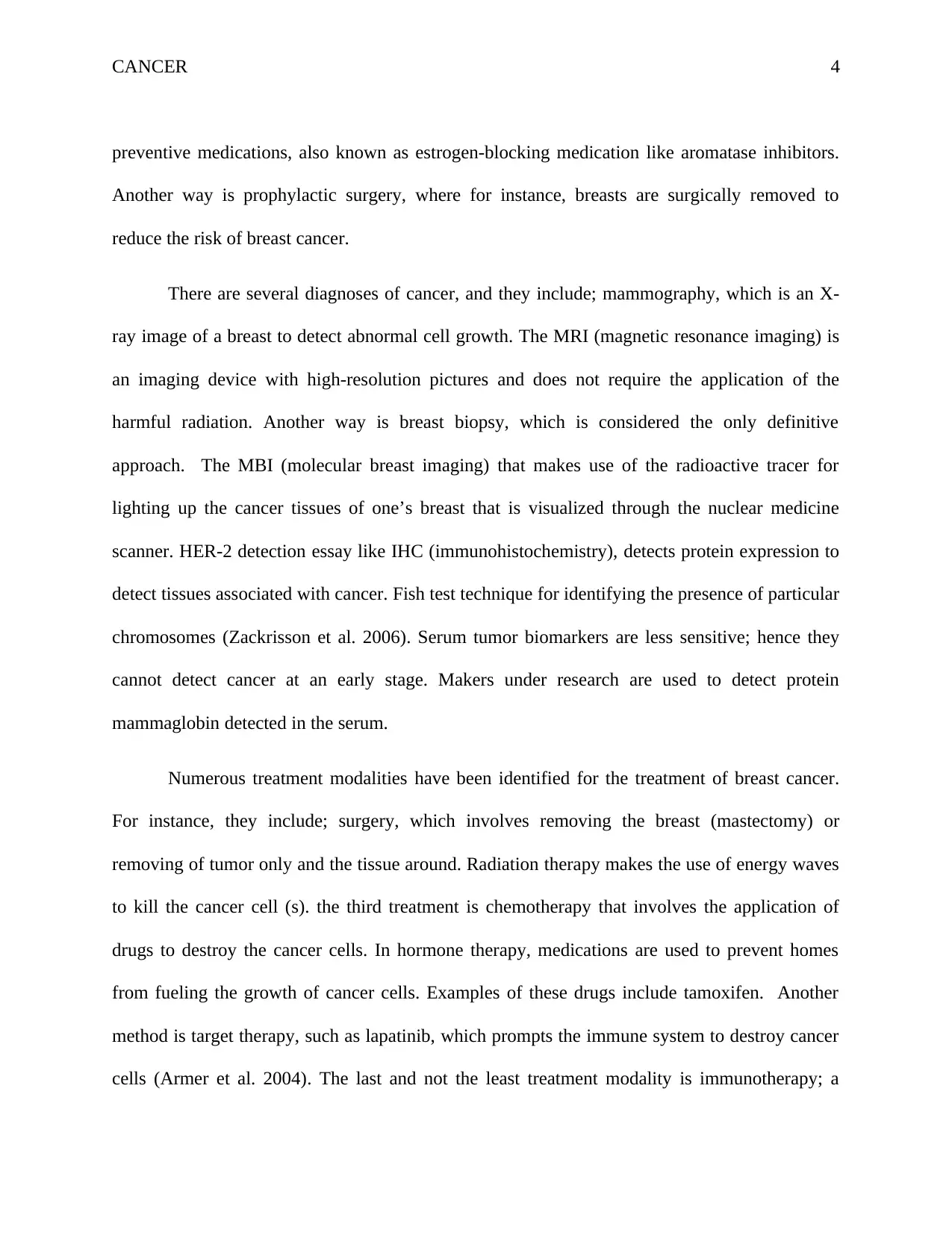
CANCER 4
preventive medications, also known as estrogen-blocking medication like aromatase inhibitors.
Another way is prophylactic surgery, where for instance, breasts are surgically removed to
reduce the risk of breast cancer.
There are several diagnoses of cancer, and they include; mammography, which is an X-
ray image of a breast to detect abnormal cell growth. The MRI (magnetic resonance imaging) is
an imaging device with high-resolution pictures and does not require the application of the
harmful radiation. Another way is breast biopsy, which is considered the only definitive
approach. The MBI (molecular breast imaging) that makes use of the radioactive tracer for
lighting up the cancer tissues of one’s breast that is visualized through the nuclear medicine
scanner. HER-2 detection essay like IHC (immunohistochemistry), detects protein expression to
detect tissues associated with cancer. Fish test technique for identifying the presence of particular
chromosomes (Zackrisson et al. 2006). Serum tumor biomarkers are less sensitive; hence they
cannot detect cancer at an early stage. Makers under research are used to detect protein
mammaglobin detected in the serum.
Numerous treatment modalities have been identified for the treatment of breast cancer.
For instance, they include; surgery, which involves removing the breast (mastectomy) or
removing of tumor only and the tissue around. Radiation therapy makes the use of energy waves
to kill the cancer cell (s). the third treatment is chemotherapy that involves the application of
drugs to destroy the cancer cells. In hormone therapy, medications are used to prevent homes
from fueling the growth of cancer cells. Examples of these drugs include tamoxifen. Another
method is target therapy, such as lapatinib, which prompts the immune system to destroy cancer
cells (Armer et al. 2004). The last and not the least treatment modality is immunotherapy; a
preventive medications, also known as estrogen-blocking medication like aromatase inhibitors.
Another way is prophylactic surgery, where for instance, breasts are surgically removed to
reduce the risk of breast cancer.
There are several diagnoses of cancer, and they include; mammography, which is an X-
ray image of a breast to detect abnormal cell growth. The MRI (magnetic resonance imaging) is
an imaging device with high-resolution pictures and does not require the application of the
harmful radiation. Another way is breast biopsy, which is considered the only definitive
approach. The MBI (molecular breast imaging) that makes use of the radioactive tracer for
lighting up the cancer tissues of one’s breast that is visualized through the nuclear medicine
scanner. HER-2 detection essay like IHC (immunohistochemistry), detects protein expression to
detect tissues associated with cancer. Fish test technique for identifying the presence of particular
chromosomes (Zackrisson et al. 2006). Serum tumor biomarkers are less sensitive; hence they
cannot detect cancer at an early stage. Makers under research are used to detect protein
mammaglobin detected in the serum.
Numerous treatment modalities have been identified for the treatment of breast cancer.
For instance, they include; surgery, which involves removing the breast (mastectomy) or
removing of tumor only and the tissue around. Radiation therapy makes the use of energy waves
to kill the cancer cell (s). the third treatment is chemotherapy that involves the application of
drugs to destroy the cancer cells. In hormone therapy, medications are used to prevent homes
from fueling the growth of cancer cells. Examples of these drugs include tamoxifen. Another
method is target therapy, such as lapatinib, which prompts the immune system to destroy cancer
cells (Armer et al. 2004). The last and not the least treatment modality is immunotherapy; a
Secure Best Marks with AI Grader
Need help grading? Try our AI Grader for instant feedback on your assignments.
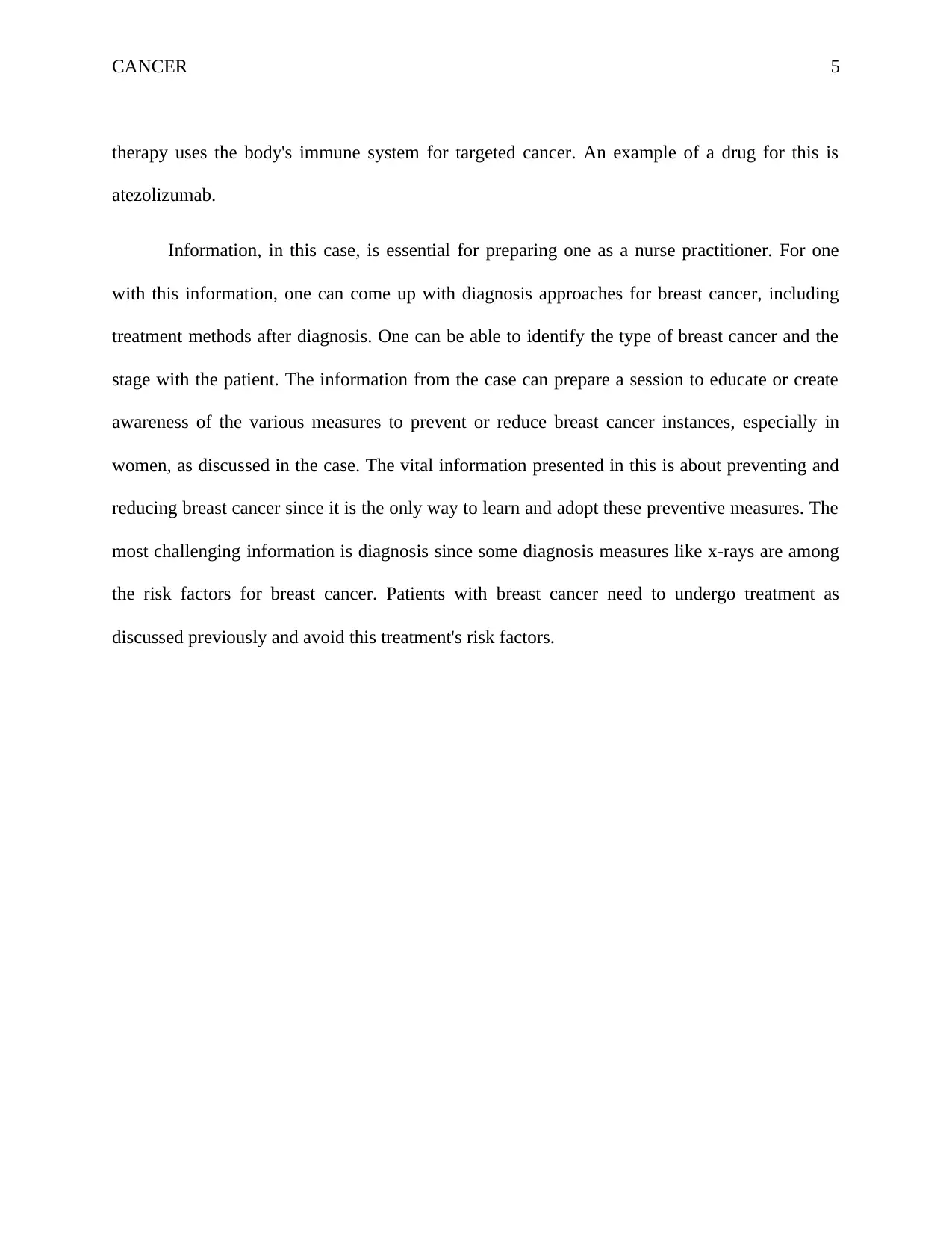
CANCER 5
therapy uses the body's immune system for targeted cancer. An example of a drug for this is
atezolizumab.
Information, in this case, is essential for preparing one as a nurse practitioner. For one
with this information, one can come up with diagnosis approaches for breast cancer, including
treatment methods after diagnosis. One can be able to identify the type of breast cancer and the
stage with the patient. The information from the case can prepare a session to educate or create
awareness of the various measures to prevent or reduce breast cancer instances, especially in
women, as discussed in the case. The vital information presented in this is about preventing and
reducing breast cancer since it is the only way to learn and adopt these preventive measures. The
most challenging information is diagnosis since some diagnosis measures like x-rays are among
the risk factors for breast cancer. Patients with breast cancer need to undergo treatment as
discussed previously and avoid this treatment's risk factors.
therapy uses the body's immune system for targeted cancer. An example of a drug for this is
atezolizumab.
Information, in this case, is essential for preparing one as a nurse practitioner. For one
with this information, one can come up with diagnosis approaches for breast cancer, including
treatment methods after diagnosis. One can be able to identify the type of breast cancer and the
stage with the patient. The information from the case can prepare a session to educate or create
awareness of the various measures to prevent or reduce breast cancer instances, especially in
women, as discussed in the case. The vital information presented in this is about preventing and
reducing breast cancer since it is the only way to learn and adopt these preventive measures. The
most challenging information is diagnosis since some diagnosis measures like x-rays are among
the risk factors for breast cancer. Patients with breast cancer need to undergo treatment as
discussed previously and avoid this treatment's risk factors.
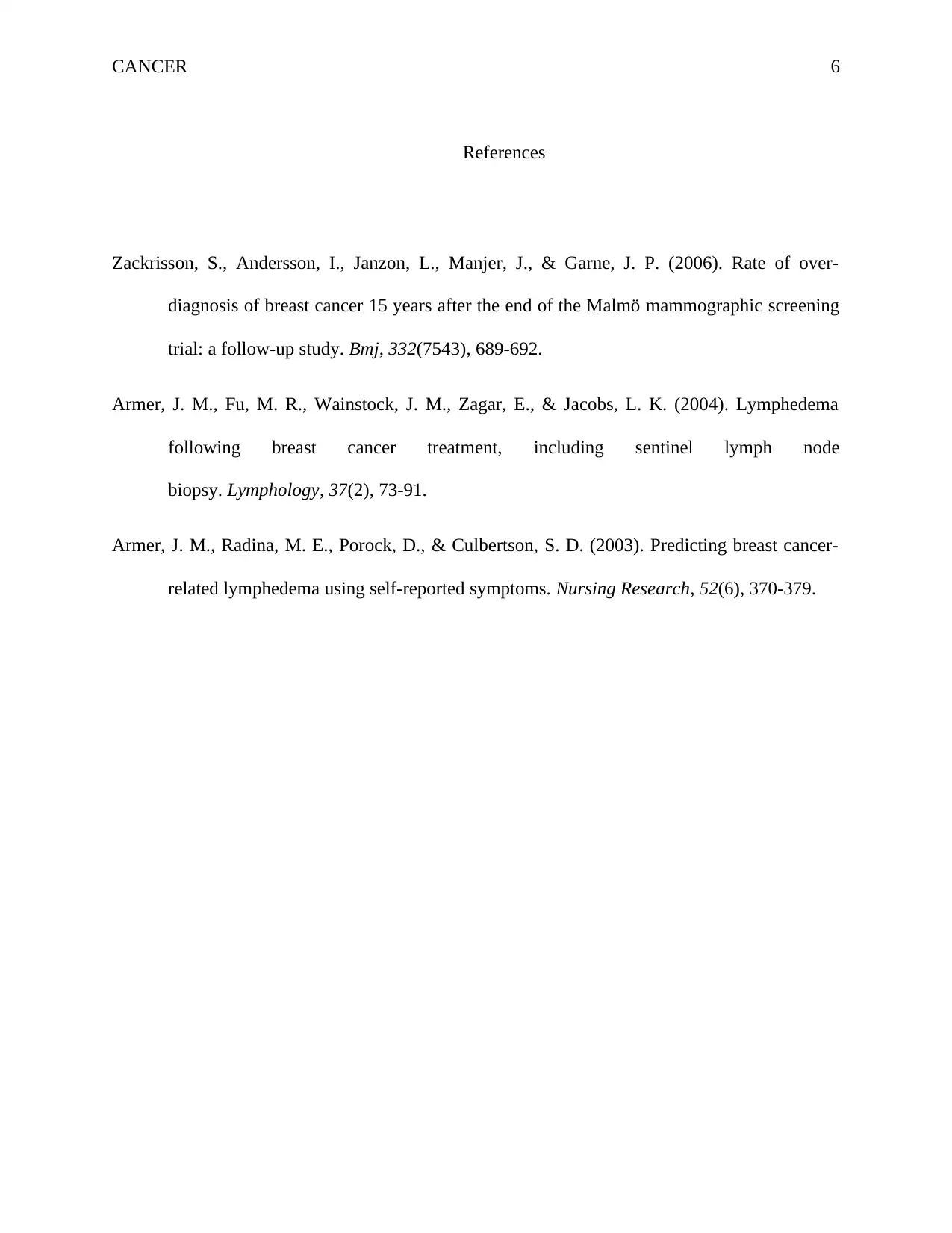
CANCER 6
References
Zackrisson, S., Andersson, I., Janzon, L., Manjer, J., & Garne, J. P. (2006). Rate of over-
diagnosis of breast cancer 15 years after the end of the Malmö mammographic screening
trial: a follow-up study. Bmj, 332(7543), 689-692.
Armer, J. M., Fu, M. R., Wainstock, J. M., Zagar, E., & Jacobs, L. K. (2004). Lymphedema
following breast cancer treatment, including sentinel lymph node
biopsy. Lymphology, 37(2), 73-91.
Armer, J. M., Radina, M. E., Porock, D., & Culbertson, S. D. (2003). Predicting breast cancer-
related lymphedema using self-reported symptoms. Nursing Research, 52(6), 370-379.
References
Zackrisson, S., Andersson, I., Janzon, L., Manjer, J., & Garne, J. P. (2006). Rate of over-
diagnosis of breast cancer 15 years after the end of the Malmö mammographic screening
trial: a follow-up study. Bmj, 332(7543), 689-692.
Armer, J. M., Fu, M. R., Wainstock, J. M., Zagar, E., & Jacobs, L. K. (2004). Lymphedema
following breast cancer treatment, including sentinel lymph node
biopsy. Lymphology, 37(2), 73-91.
Armer, J. M., Radina, M. E., Porock, D., & Culbertson, S. D. (2003). Predicting breast cancer-
related lymphedema using self-reported symptoms. Nursing Research, 52(6), 370-379.
1 out of 6
Related Documents
Your All-in-One AI-Powered Toolkit for Academic Success.
+13062052269
info@desklib.com
Available 24*7 on WhatsApp / Email
![[object Object]](/_next/static/media/star-bottom.7253800d.svg)
Unlock your academic potential
© 2024 | Zucol Services PVT LTD | All rights reserved.





